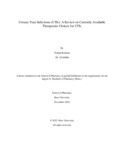| dc.contributor.advisor | Rahman, Kazi Fatema | |
| dc.contributor.author | Rohman, Tamjid | |
| dc.date.accessioned | 2023-07-09T09:38:44Z | |
| dc.date.available | 2023-07-09T09:38:44Z | |
| dc.date.copyright | 2022 | |
| dc.date.issued | 2022-11 | |
| dc.identifier.other | ID: 18346006 | |
| dc.identifier.uri | http://hdl.handle.net/10361/18693 | |
| dc.description | This thesis is submitted in partial fulfillment of the requirements for the degree of Bachelor of Pharmacy, 2022. | en_US |
| dc.description | Cataloged from PDF version of thesis. | |
| dc.description | Includes bibliographical references (pages 42-48). | |
| dc.description.abstract | Urinary tract infections (UTIs) are commonly occurring infections that have become a major
public health problem worldwide. They can be caused by both Gram-negative and Gram-positive
bacteria, as well as by some species of fungi. However, Gram-negative bacteria, especially,
Escherichia coli (UPEC), and Klebsiella pneumonia are primarily responsible for UTIs. Infections
initiate in the urinary tract and may eventually culminate in severe complications such as kidney
damage, bacteremia, or even death. Age, gender, anatomy, and ethnicity are the main risk factors
for UTIs. Women and elderly people are most susceptible to UTIs due to their anatomical features
and age. Currently, therapeutic options for managing UTIs include both antibiotic and non antibiotic therapy. Though antibiotics represent first-line treatment choices for UTIs, the
emergence of multidrug-resistant bacterial strains often results in treatment failure and recurrent
infections. These factors further add to patients’ sufferings and the economic burden of the disease.
Research is currently underway to develop better diagnostic tools, drug therapies, and efficient
delivery systems to tackle antimicrobial resistance. This review aims to provide an overview of
UTIs and currently available therapeutic options, particularly focusing on challenges associated
with the development of antimicrobial resistance (AMR) and multi-drug resistance (MDR) in UTI
therapy. | en_US |
| dc.description.statementofresponsibility | Tamjid Rohman | |
| dc.format.extent | 48 pages | |
| dc.language.iso | en | en_US |
| dc.publisher | Brac University | en_US |
| dc.rights | Brac University theses are protected by copyright. They may be viewed from this source for any purpose, but reproduction or distribution in any format is prohibited without written permission. | |
| dc.subject | Urinary tract infections | en_US |
| dc.subject | Antibiotic therapy | en_US |
| dc.subject | Non-antibiotic therapy | en_US |
| dc.subject | Antimicrobial resistance (AMR) | en_US |
| dc.subject | Multi-drug resistance (MDR) | en_US |
| dc.subject | Metagenomic sequencing (MGS) | en_US |
| dc.subject | Nanoparticles (NP). | en_US |
| dc.subject.lcsh | Urinary Tract Infections--therapy. | |
| dc.title | Urinary Tract Infections (UTIs): A review on currently available therapeutic choices for UTIs | en_US |
| dc.type | Thesis | en_US |
| dc.contributor.department | Department of Pharmacy, Brac University | |
| dc.description.degree | B. Pharmacy | |

